Bellows were common devices long before spirometers and the first bellows spirometers were developed in the late 1800’s. The first were accordian-style. These were followed starting around 1900 by wedge bellows. Bellows spirometers were often called dry spirometers to differentiate them from the water-seal (wet) bell spirometers.
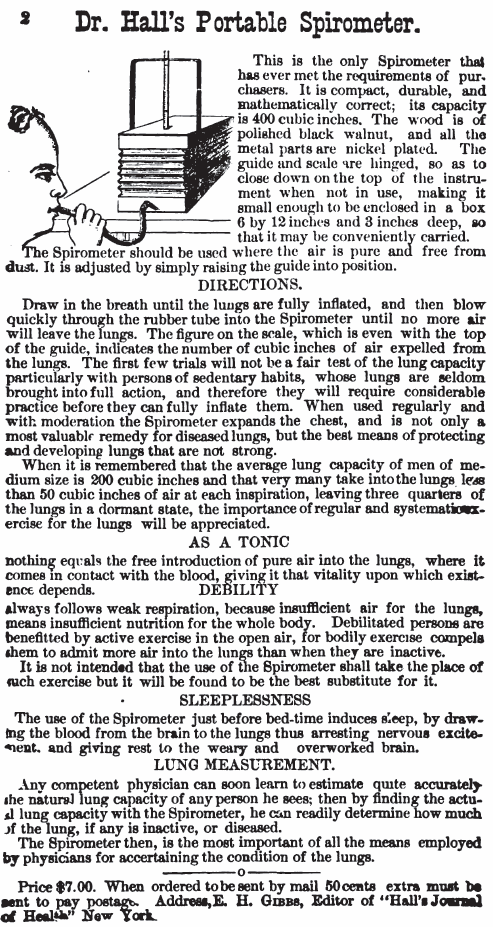
Hall’s Spirometer, 1879. From: Hall’s Journal of Health, Volume 26, March, 1879, Frontispiece III.
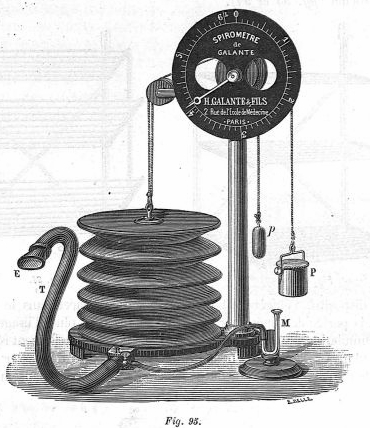
Galante Spirometer, 1891. From Journal of surgical instruments, 1891, page 92. Found on the Medic Database. Image: med110220x1891x0088
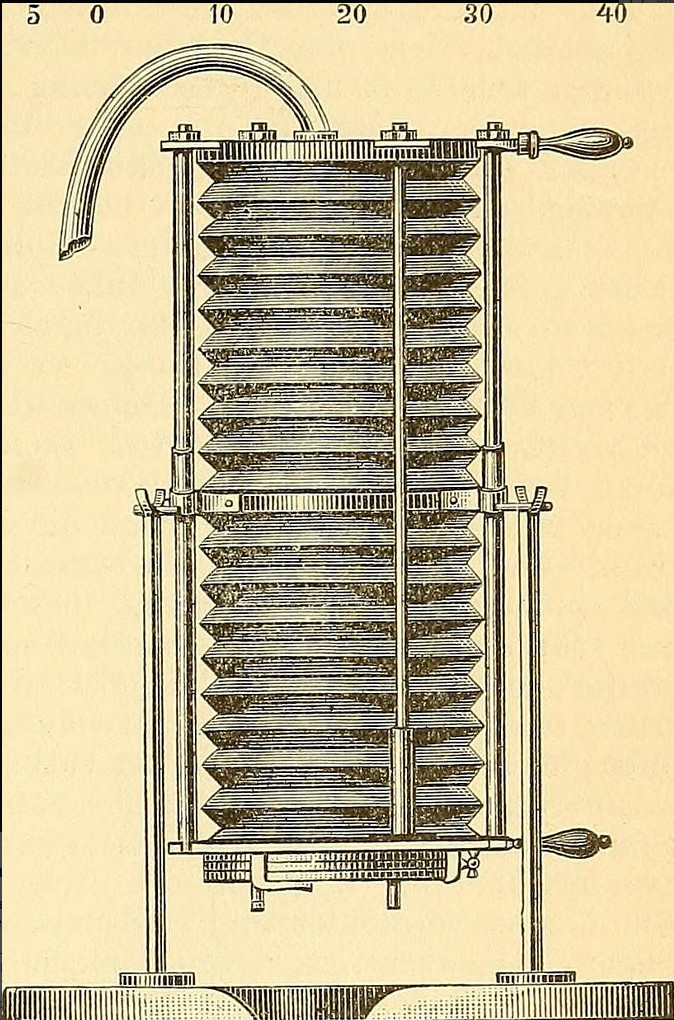
Biedert Spirometer, 1891. A bellows spirometer designed to provide compressed and rarified air based on the therapies developed by Waldenberg in the 1870’s. This spirometer was designed/manufactured by Biedert. Found on Flickr. Attributed to “Therapeutisches Lexikon : für praktische Ärzte”, by Anton Bum and Carl Breus, published 1891, page 676.
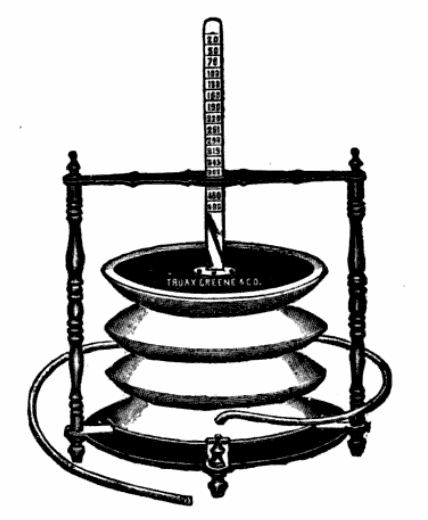
Denison’s Spirometer, 1895. From: The early detection of Pthisis, including the author’s contributions to diagnostic means, with after considerations of a possible pre-tubercular stage, by Charles Denison, MD. Transactions of the First Pan-American Medical Congress, Part 2, U.S. Government Printing Office, 1895, page 2001.
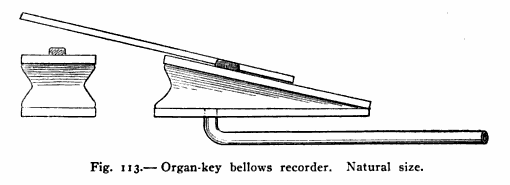
Brodie’s Bellows Tambour, developed 1903. Strictly speaking this is a tambour and not a spirometer. It was intended for experiments with small animals or in venous occlusion plethysmography, the bellows are approximately 3 cm long. It was usually referred to as a recording tambour.
Found in A Text-book of Pharmacology and Some Allied Sciences:(therapeutics, Materia Medica, Pharmacy, Prescription-writing, Toxicology, Etc.), Together with Outlines for Laboratory Work; Solubility and Dose Tables, Etc, by Torald Hermann Sollman, published by W.B. Saunders, 1913, page 815.
“Recording Tambours: The cheapest form consists of a home-made organ-bellow (fig. 113), the sides of very thin leather or gold-beaters skin. A 3 or 4 cm Marey’s tambour answers well. The 3 cm Brodie Bellows (Made by C.F. Palmer, 6 Upper Tulso Hill, London, N.W.) is the most delicate. All bear a straw and a writing point about 6 inches long.”
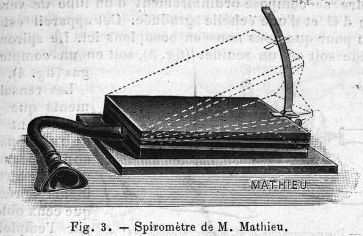
Mathieu’s Spirometer, 1903. From: Traité d’hygiène, By Paul Brouardel, Ernest Mosny, Charles Dopter, Jean Rouget. Published by J. B. Baillière, 1906, page 22.
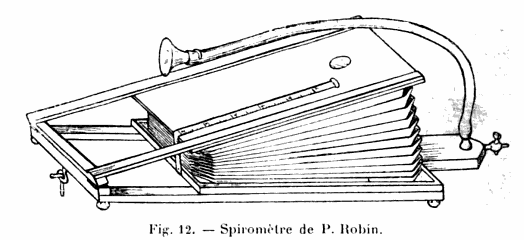
Robin’s Spirometer, 1906. From: Traité d’hygiène, By Paul Brouardel, Ernest Mosny, Charles Dopter, Jean Rouget. Published by J. B. Baillière, 1906, page 22.
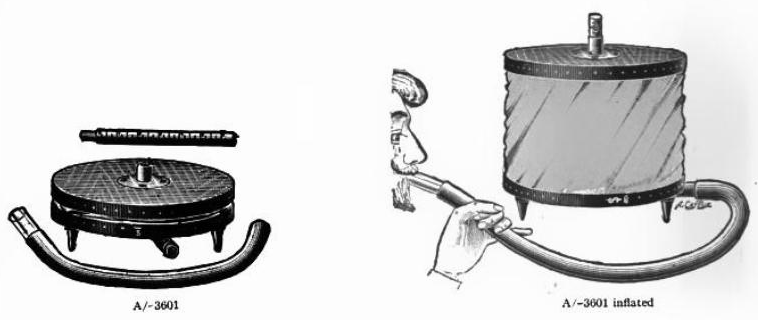
Boulitte Spirometer, 1915. From : Illustrations of surgical instruments of superior quality. [Catalogue], By Kny-Scheerer Company, 1915, page 1076.
“Inflatable bag is made of specially treated linen. $25.00”
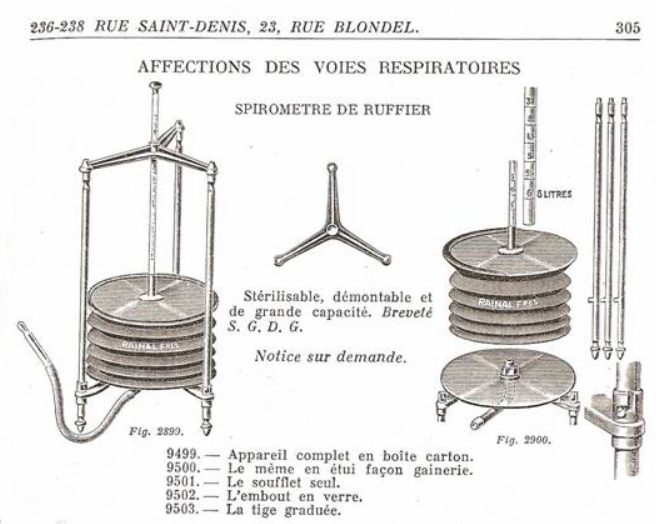
Ruffier Spirometer, 1920’s. From a powerpoint presentation entitled “A la decouverte … du souffle” by Jean-Francois Dessanges. The title translates approximately as “the discovery was breathless”. This drawing is from a Rainal Brothers catalog. Edward James Ruffier patented his spirometer in 1924.
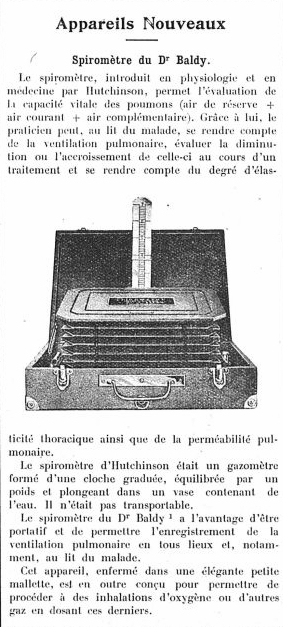
Spirometer du Dr. Baldy, 1936. From La Presse Medicale, Jan 8, 1936, page 61. Found on the Medic Database. Image med100000x1936xartorigx0065
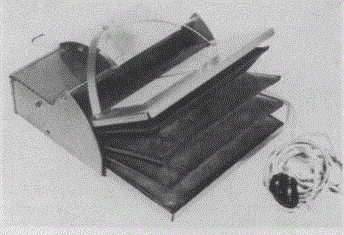
McKesson Vitalor, 1961. From: JAMA, 1961 Sep 23. Volume 177, page 865. A dry wedge bellows spirometer. A pen attached to the lid of the bellows wrote on a small sheet of graph paper that was driven horizontally by an electric motor during exhalation.
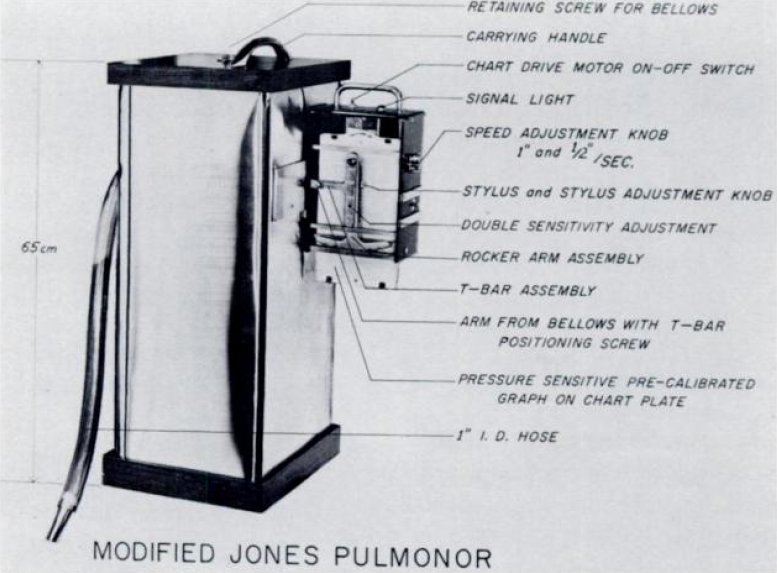
Jones Pulmonor Spirometer, 1963. Although not obvious from the outside, there was an internal bellows. From: Vance JW. A bellows-type spirometer for measuring the forced expirogram. Chest. 1963; 43(1):57-61
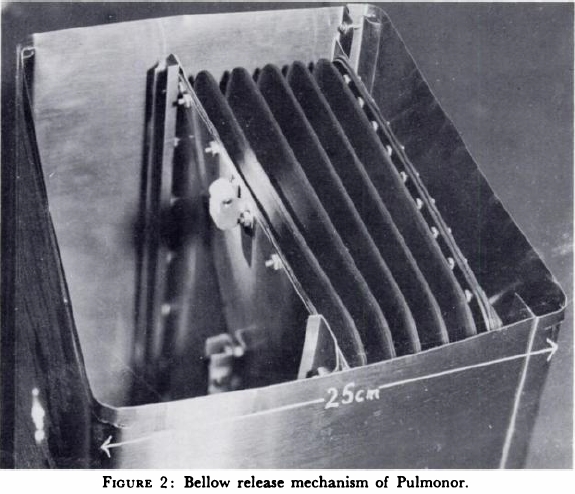
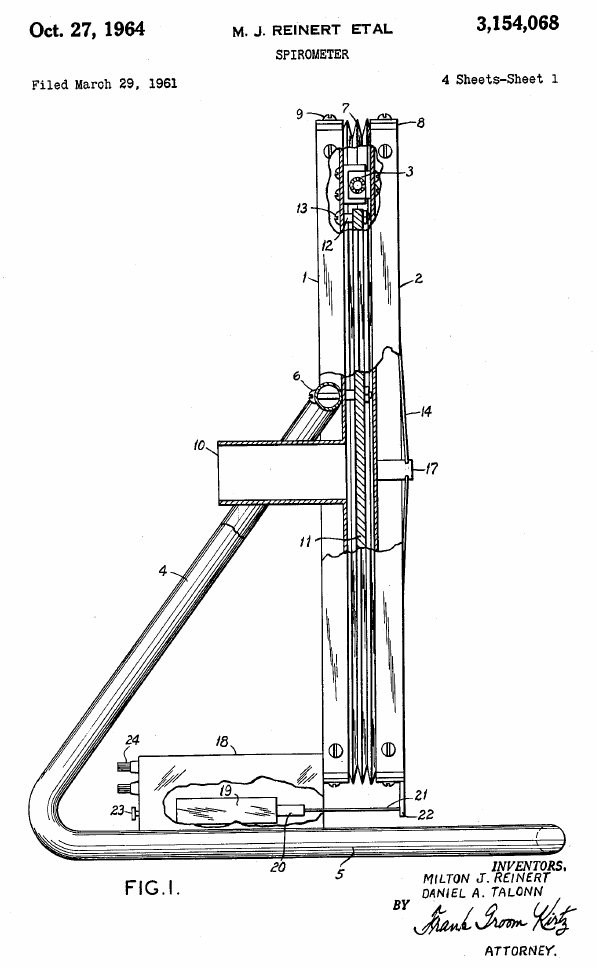
Med-Science wedge bellows spirometer, 1964. A drawing from patent #3,154,068, submitted 1961, approved 1964.
“Another object of the invention is to provide a high dynamics spirometer. The instrument is designed to have small travel of the parts in motion corresponding to large volume differentials or changes in volume. Therefore large volumetric acceleration with correspond to small linear acceleration. Since for a given mass in motion, the lower the accelerations, the higher will be the frequency response.
“Another object of the invention is to provide a spirometer which will offer all the known functions of previous spirometers, and at the same time provide an electrical readout of both volume change and flow changes. These two measurements are entirely independent. Previous to this invention, no patient-driven spirometer has been capable of independent readout of volume changes and flow changes.
“The low linear acceleration results in small forces required to actuate the moving elements. Since the patient’s lungs in mechanical spirometry are required to generate the forces to drive the spirometer, it can readily be seen that the lower linear accelerations result in lower forces in the lungs to drive the spirometer. Thus the patient’s breathing is more nearly normal during the process of measurement. The effect is magnified at the point of higher dynamics, such as rapid breathing and coughing.
“In an ordinary spirometer, a patient coughing is not only affected physiologically by the higher forces of the ordinary spirometer, but the actual cough is recorded subject to the errors of the instrument at high frequencies.
“A further object of this invention is to provide a spirometer in which the ambient pressures within the spirometer and the patient’s lungs remain as close to atmospheric pressure as possible. Thus the patient does not have the feeling that something is impeding his breath, which is the case in the ordinary spirometer.”
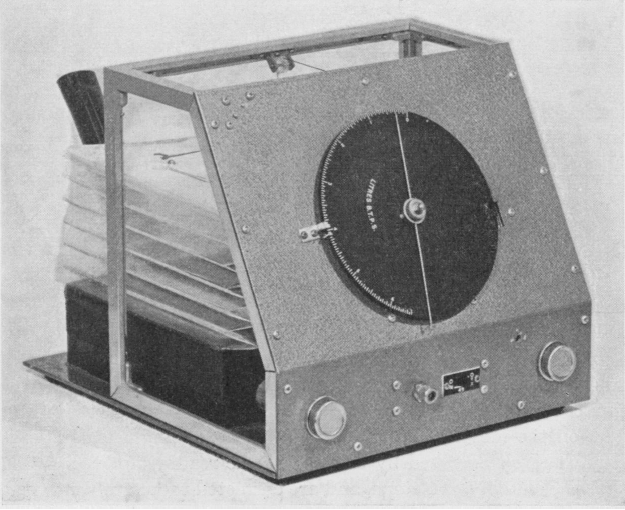
McDermott Spirometer, 1964. From: Bellows spirometer and transistor timer for the measurement of forced expired volume and vital capacity. By M.M Collins, M. McDermott and T.J. McDermott. Proceedings of the Physiological Society, Cardiff Meeting, April 17-18 1964. Page 39P.
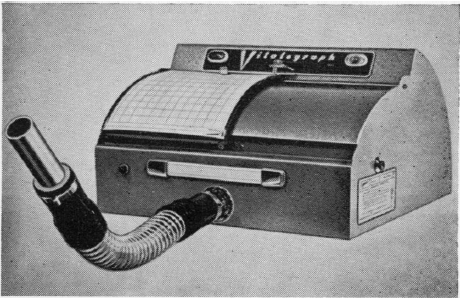
Vitalograph Spirometer, 1969. A wedge bellows spirometer. From Drew CDM, Hughes DTD. Characteristics of the Vitalograph Spirometer,Thorax, 1969; 24: 703. The first Vitalograph spirometer of this type was manufactured in 1962, the last after 2000.
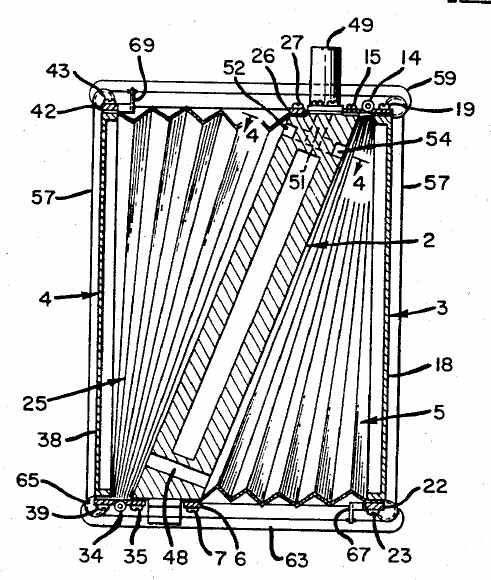
Balanced Bellows spirometer, 1969. Developed for use in space by NASA in 1969. From US patent #3,420,225.
“Accordingly, an object of this invention is to provide an improved spirometer which will operate properly even under the influence of acceleration forces in any direction.”
“By way of brief description, a balanced bellows spirometer according to the invention comprises a center wall with a bellows mounted on each side of the wall. The bellows are pivotally connected to opposite edges of the center wall and a passage through the center wall interconnects the two bellows chambers into one composite chamber. An inlet is provided into one bellows and an outlet is provided from the other bellows. The two bellows are mechanically interconnected so that the tendency of either bellows to move toward or away from the center wall under the influence of acceleration forces is resisted by an equal and opposite tendency of the other bellows to move under the influence of said acceleration. As a result, the bellows are not moved by acceleration forces and yet are free to expand and contract under the forces of air pressure.”
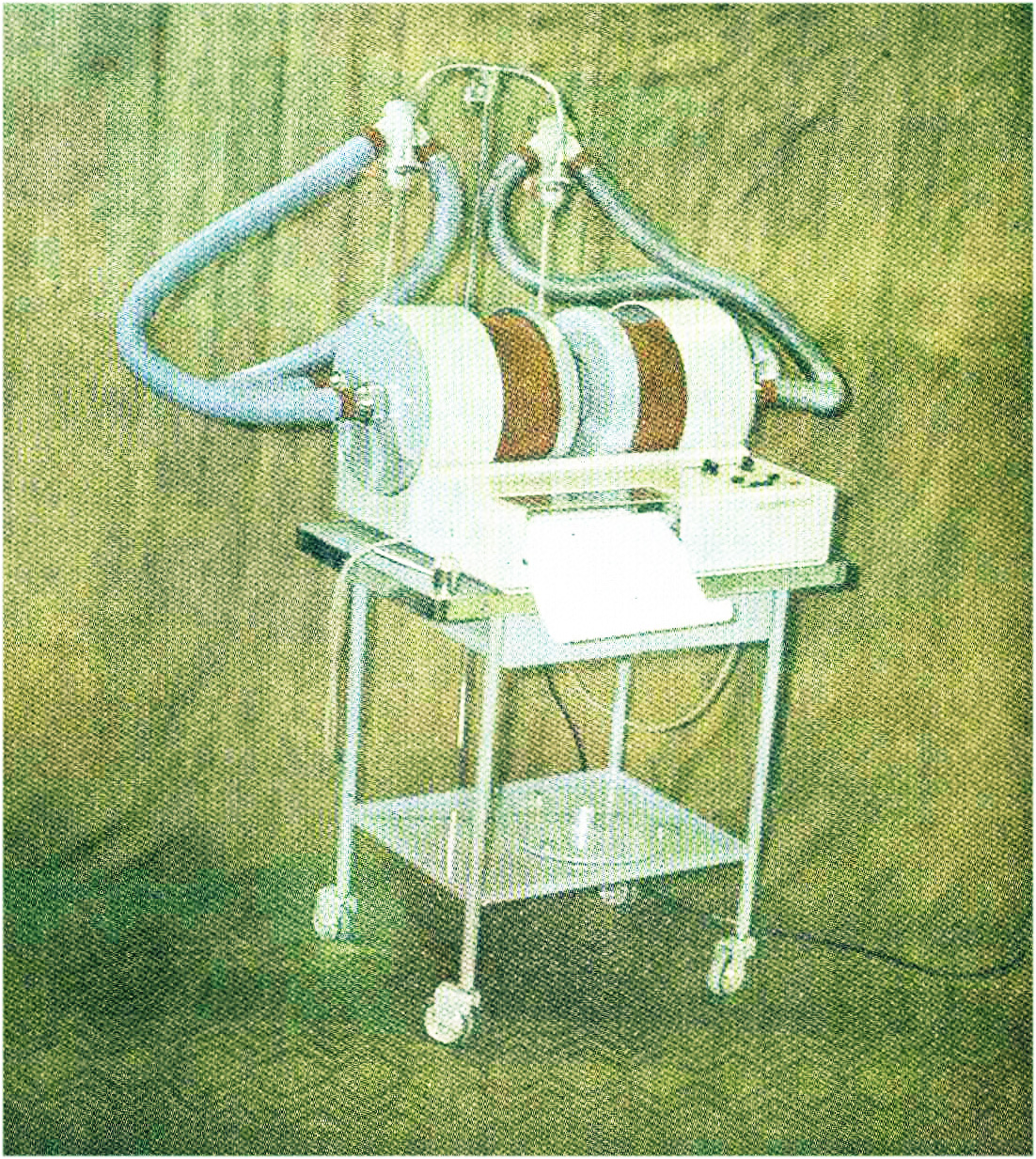 Bronchometatest, 1980’s. Metatest, a company in the USSR, manufactured a number of different bellows-based spirometers.. Photo is courtesy of Viktor Lopata, PhD, Senior Researcher of the Bogomolets Physiology Institute, Kiev, Ukraine.
Bronchometatest, 1980’s. Metatest, a company in the USSR, manufactured a number of different bellows-based spirometers.. Photo is courtesy of Viktor Lopata, PhD, Senior Researcher of the Bogomolets Physiology Institute, Kiev, Ukraine.